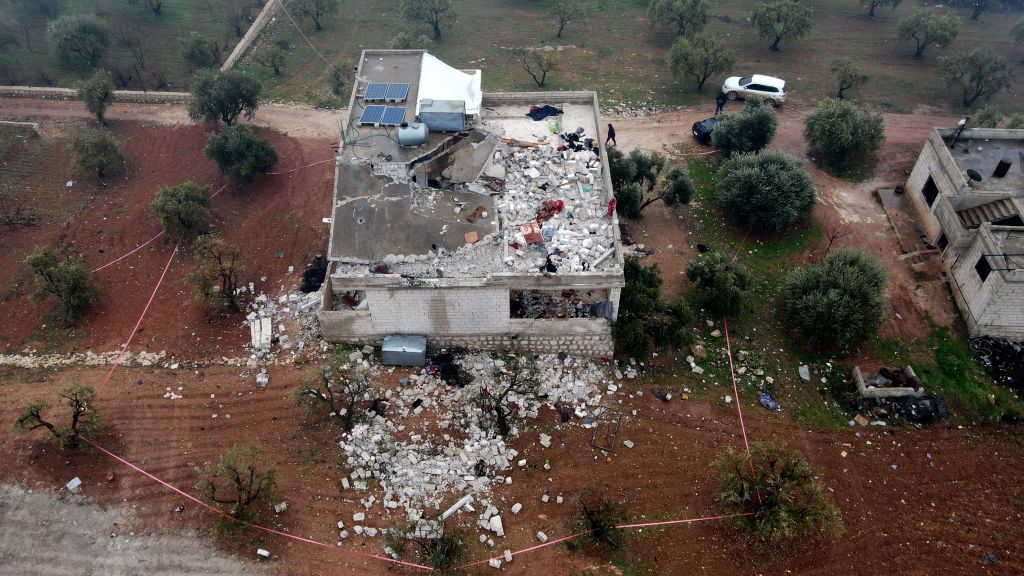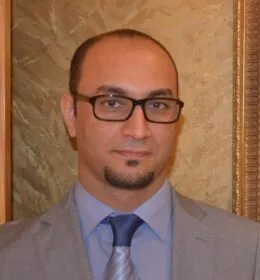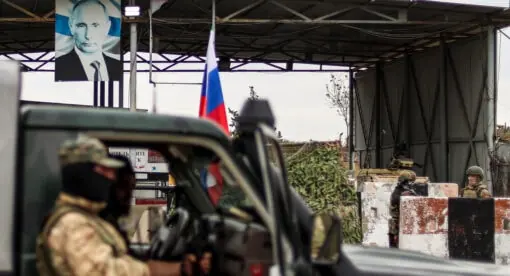Listen to article
A spate of attacks by the Islamic State group, or ISIS, in the second half of April reportedly killed hundreds. Recent developments illustrate the group’s continued ability to project power in Syria. However, they also show how weak ISIS has become in neighboring Iraq, its former center of gravity. U.S. policymakers need to assess the rising threat from ISIS in Syria and adjust their strategy for dealing with the security vacuum across parts of that country.
ISIS announced what it called the Raid of Revenge for the Two Sheikhs after the deaths earlier this year of the group’s former leader, Abu Ibrahim al-Hashimi al-Qurashi, and his spokesman, Abu Hamza al-Quraishi. An infographic in the militant group’s newspaper, al-Naba, claimed the operation lasted from April 17 to May 1, and that it comprised 245 attacks around the world that killed and wounded 726 people. These strikes include the group’s first ever claimed attack on a military base in Uzbekistan, with 10 rockets fired from across the border in Afghanistan. The operation’s final attack came in Syria – a symbolic affirmation of the continuing importance of that country to the Islamic State group, even after its 2019 defeat there in the Battle of Baghuz pushed it out of the last of the territories it had controlled.
Three years after that defeat, ISIS is strengthening, and it is escalating its attacks in Syria.
How the ISIS Threat Ebbed
During frequent reporting trips to eastern Syria across the years, this author has observed up close how the threat of ISIS has evolved. Before the Covid-19 pandemic, this author visited the region about once every three months. Even before the onset of the pandemic, it was clear that the group had shifted into a more active mode.
In 2017-2018, ISIS focused on defending its territory, striving to sustain its caliphate for as long as this was possible, and not seeking to expose itself outside its own areas of control. The organization was generally in retreat at that time. Between August 2018 and March 2019, both locals and people fighting ISIS described the group to this author as being in a state of indolence. There were clear areas of ISIS influence, but not much activity beyond the areas the group still held. When it could, ISIS relied on large-scale attacks and suicide attacks to carry out military objectives. In such a situation, precautions and countermeasures by U.S.-backed forces were easier to take. Urban centers such as Hasakah, Qamishli, Busayrah, and Gharanij were somewhat safe. There were no open military battles, and there was a semblance of security.
After ISIS lost its last stronghold, Baghuz, in the spring of 2019, this author visited all of the areas where the group once held territory in eastern and northeastern Syria. The difference from previous visits was tangible: The security situation in the area was vastly improved, and there was a sense of safety when traveling. But in November of that year, this started to change. Fear of the organization started to return. ISIS sleeper cells carried out attacks, and the security situation degraded in areas supposedly controlled by the Syrian Democratic Forces, or SDF, and the Syrian regime. No clear strategy to deal with the post-caliphate phase existed.
It was unclear where the group operated, who supported it within the community, or how to deal with its increased nighttime attacks. There was no major military threat, but fear of terrorist attacks and assassinations was widespread. The U.S.-led coalition cooperated with selected individuals in these communities. But many people either were alienated by or feared working with foreign-backed forces, and in this atmosphere of mistrust, the group was able to build its sleeper cells.
In 2020 and 2021, ISIS relied mostly on those sleeper cells and on non-member collaborators, regrouping and attacking on a steady if low-intensity basis. Today, the situation remains the same. An established, low-intensity ISIS insurgency ebbs and flows through certain areas depending on the security forces’ weakness and ability to focus on threats. Thus, given a few domestic and regional factors, ISIS is currently regenerating across much of Syria – especially in relation to its presence in Iraq, which was once its main center of operations.
The Islamic State Regains Strength
An early sign that the Islamic State was regaining strength in Syria was the January attack on the SDF-run Ghweiran prison in Hasakah. Islamic State fighters assaulted the prison with an explosives-laden vehicle, allowing more than 100 of the group’s members, including some leaders, to escape to the Badiyah, Syria’s expansive desert region, and prompting a days-long revolt in the prison. ISIS hailed the operation as a victory – in addition to freeing several leaders, the group was able to attack a supposedly well-guarded prison.
The operation re-energized the group. It enabled the escape of dozens of leaders to the deserts of central Syria, and the organization mobilized its sleeper cells in order to capitalize on the momentum created by the prison break. The intensity of terrorist operations against the SDF east of the Euphrates increased, with dozens of attacks against those forces in the eastern Deir ez-Zor countryside. The events in eastern Syria reinforced the group’s presence in the Badiyah along the Syrian-Iraqi border between Damascus and Homs – especially around the areas of Sukhna, Palmyra and al-Qaryatain.
However, ISIS suffered a major blow when a U.S. special operation in Idlib on Feb. 3 succeeded in eliminating al-Qurashi. The group announced in March that Abu al-Hasan al-Qurashi would be his successor, and the spate of April attacks likely was aimed at bolstering support for the new leader.
Shifting Focus
ISIS’s recent successes in Syria denote a shift away from Iraq. The group is taking advantage of Syria’s fragile security environment, as well as its own ability to move through the country’s northeast and the Badiyah.
Meanwhile, Iraq has benefited from its years of experience fighting ISIS and has gained an advantage in the conflict, recently killing fighters in Ninewa and Mosul. A spokesperson for Iraq’s armed forces, Maj.-Gen. Yahya Rasul, said that “what has remained of ISIS in Iraq is basically some remnants of the group here and there, concentrated in desert regions of large areas punctured by valleys and a harsh geographical nature.” He added that “what is present within these areas is some terrorist cells with around two to three personnel and sometimes six personnel.” Rasul further added that the Iraqi army had destroyed ISIS’s ability to hold territory – the group is now operating only as terrorist cells.
Another reason for the group’s shift toward Syria has been Russia’s focus on its invasion of Ukraine. Fighting alongside the Syrian regime and Iran, Russia had spearheaded the military campaign against ISIS outside the areas where the U.S.-led coalition operates. This has been especially visible in the areas between Deir ez-Zor and the Badiyah since 2017. The Kremlin has provided logistics, militias, military expertise, and air support to track and fight ISIS fighters in the desert region along the Syrian-Iraqi border. While it has drawn its focus away for now, Moscow does remain well aware of the dangers the group poses in Syria – especially after ISIS targeted Russian economic interests such as gas lines in the country.
The group’s presence between Deir ez-Zor and the Badiyah has been especially stubborn. The desert is mountainous and sparsely populated, and there has been no systematic, persistent military and security campaign to track militants and drive them out of these impossible-to-police areas. Both the group and its enemies here are used to a rhythm of fighting that perpetuates the situation: ISIS fighters conduct swift, small, and disruptive attacks, then they leave before their enemies arrive at the scene. The lack of sophisticated tools to track the militants prevents any sustained campaign against a group that is now largely regarded as a low priority. Meanwhile, the group reportedly has been recruiting people living in poverty in these areas, as well as extorting and attacking businesses and assassinating leaders.
With the more sophisticated and better equipped Russian forces preoccupied, Syrian regime forces and Iran-backed militias have sent hundreds of fighters to confront the Islamic State in the Badiyah. The group has responded with several attacks in the region after the end of its April operation. This author’s sources say the group has killed dozens of troops from the Syrian 4th Division. More important, it has taken several as hostages, increasing the militants’ leverage in negotiations. Moscow has demanded that Lebanon’s Hezbollah deploy forces to the Badiyah, and Russia has strengthened military deployments in Mahin, Sadad, and al-Qaryatain in Homs, all of which have been previously targeted by ISIS. Sources say that in the coming days we can expect to see Russian forces in the country engage in high-level coordination with Syrian military intelligence and Hezbollah militiamen.
Much of the blame for ISIS’s surge in Syria lies with the U.S.-led international coalition that was established to counter the transnational jihadist entity. The coalition has failed to develop a viable political economy in the areas liberated from ISIS in northeast Syria. Its security-focused strategy has proved unable to rehabilitate the local populace and encourage it to reject the militants and their ideology. These shortcomings have allowed the jihadists to regroup and respread.
In the aftermath of the Ghweiran prison attack, the SDF has had to reinforce its presence in the desert region. The SDF is trying to prevent ISIS from regaining its posture after the blow it received when al-Qurashi died.
As is tradition, when the group loses high-profile members and must appoint a new leader, it uses revenge attacks to provide the new leader with confidence and credibility. The group must show it is capable of making an impact on the ground, and it must appear strong in the eyes of the group’s rank and file. Particularly since his predecessor’s killing came as a big shock to the organization, Abu al-Hasan al-Qurashi had to organize retribution for the killing of the two sheikhs. The campaign was seen as critical to sustaining the organization’s morale. It succeeded in its purpose, attracting dozens of young recruits from across Syria to the organization in the Deir ez-Zor region.
The Islamic State’s activities over the past three months in Syria and Iraq show that the group retains the ability for offensive action and thus constitutes a major security threat. The attacks also show that the preceding period of inactivity masked the fact that ISIS was regrouping and setting the stage for a comeback. ISIS militants are capable of projecting themselves in Syria more than Iraq. This is because of the fragile security situation overall in Syria, as well as the organization’s ability to move throughout northeast Syria and its desert region – an area that has witnessed intense battles with Iranian militias and the Syrian army.
In contrast, in Iraq, state security forces have the upper hand thanks to the experience of the Iraqi army and the Shiite militia alliance known as the Popular Mobilization Forces. Recently, combined forces of regular troops and militiamen delivered painful defeats to militants in Ninawa province; the army managed to kill dozens of ISIS fighters.
Demographics work against ISIS in Iraq, and Baghdad’s security forces and the militias have served as a robust counter, severely limiting an ISIS resurgence. In Syria, however, the Kurdish-dominated SDF are not capable of confronting the organization by themselves.
Building a force capable of countering the group requires the incorporation of local Sunni Arab forces who have both the requisite tradecraft and experience in dealing with the local situation.
ISIS Cannot Be Ignored
The intensity and spread of the Islamic State’s recent operations highlight the effectiveness of the group’s operational planning and execution. This explains how it has been able to revive its operations, giving a critical boost to the morale of its members and supporters. By taking advantage of the fragile security in northeastern Syria and the desert areas, ISIS shows that it is well on the path to revitalizing itself. It will obviously take a while for ISIS to fully reorganize and increase the tempo of its attacks, but we have to assume that it is trying to take advantage of the recent decline in Russian air operations in Syria. This has become patently clear through the expansion of its operations in the Badiyah region, where the Syrian army and Iranian militias have sent hundreds of fighters to confront the group in its regenerative stage. ISIS continues its kinetic activities in the Badiyah, creating a “triangle of death” for the forces of the Syrian military’s 4th Division and the Iranian-controlled militias, though its propaganda furnishes few operational details.
According to some sources the author has spoken to, the jihadist movement has launched major attacks on positions belonging to the 4th Division and pro-Tehran militias to the west of the city of Deir ez-Zor. These attacks have killed dozens from the ranks of the 4th Division. The more dangerous development is that ISIS has taken prisoners. This increases the group’s leverage in any negotiation with the regime, and from a military perspective, it means that battles are now taking place at close quarters. Thus, it represents an inflection point in the fight against the group’s revival.
The ISIS organization in Syria is in a new, escalatory stage. The renewed threat stems directly from the failure of the security solutions that the international coalition has put in place in recent years, and from the lack of a safe environment for the local population, which has become increasingly alienated from the fight against ISIS. Therefore, it is crucial to review and revise the U.S.-led international strategy, and to confront the jihadist movement in its core Syrian and Iraqi strongholds. It is important not to ignore the group’s revival at a time of global preoccupation with Russia’s war in Ukraine. Otherwise, ISIS will take advantage of the security and economic environment in the region, and the group will successfully reconstitute itself.
Abdullah Al-Ghadhawi has conducted extensive field research in eastern Syria over the years, and speaks frequently to Kurdish and Arab leaders as well as contacts familiar with the activities of the Islamic State on the ground. He is a Syrian journalist and analyst from Deir ez-Zor, who covered Syria and the Middle East for more than a decade, including for the Saudi newspaper Okaz and the London-based Chatham House think tank. He Tweets at @GhadawiAbdullah.
The views expressed in this article are those of the author and not an official policy or position of the Newlines Institute.






